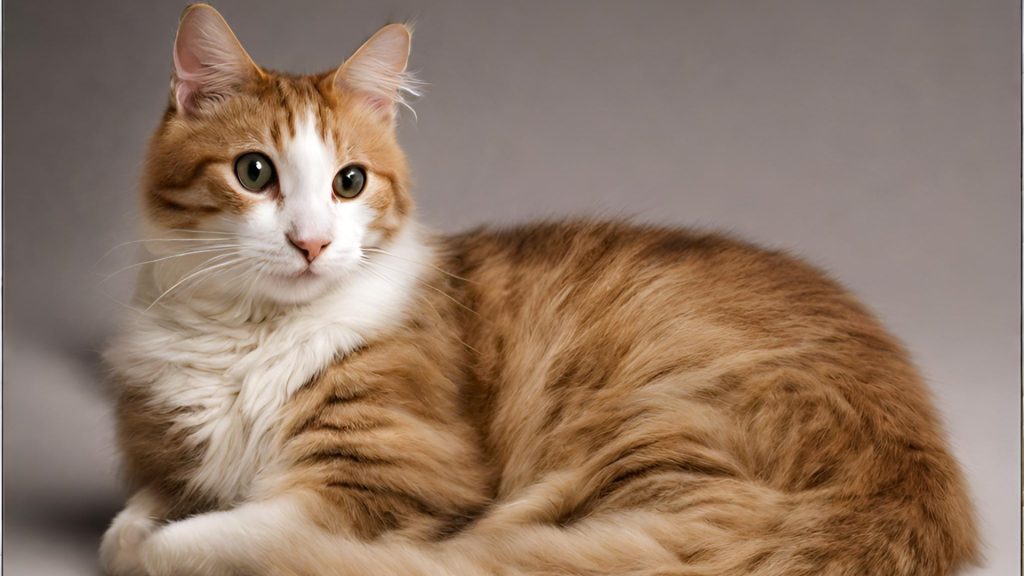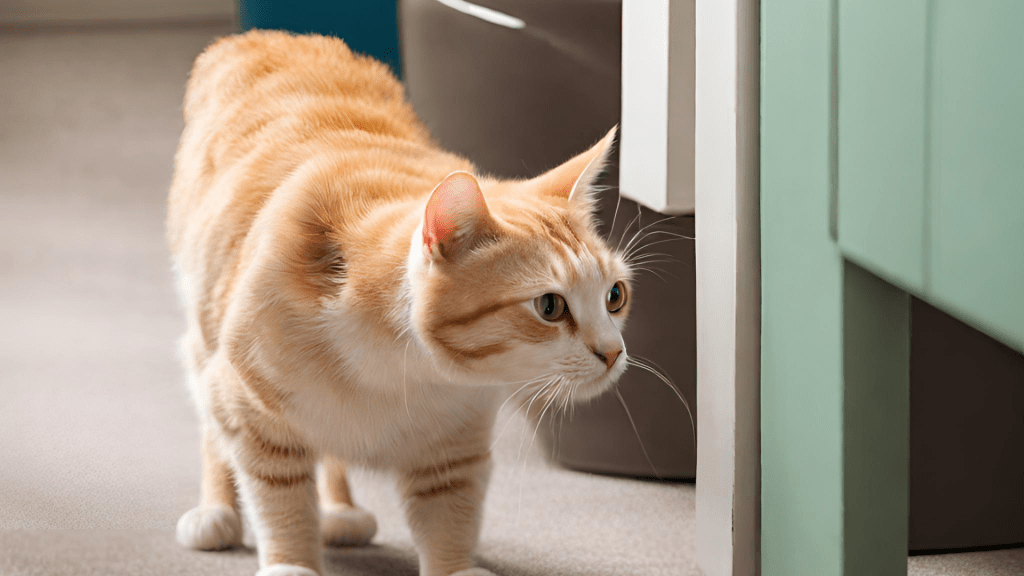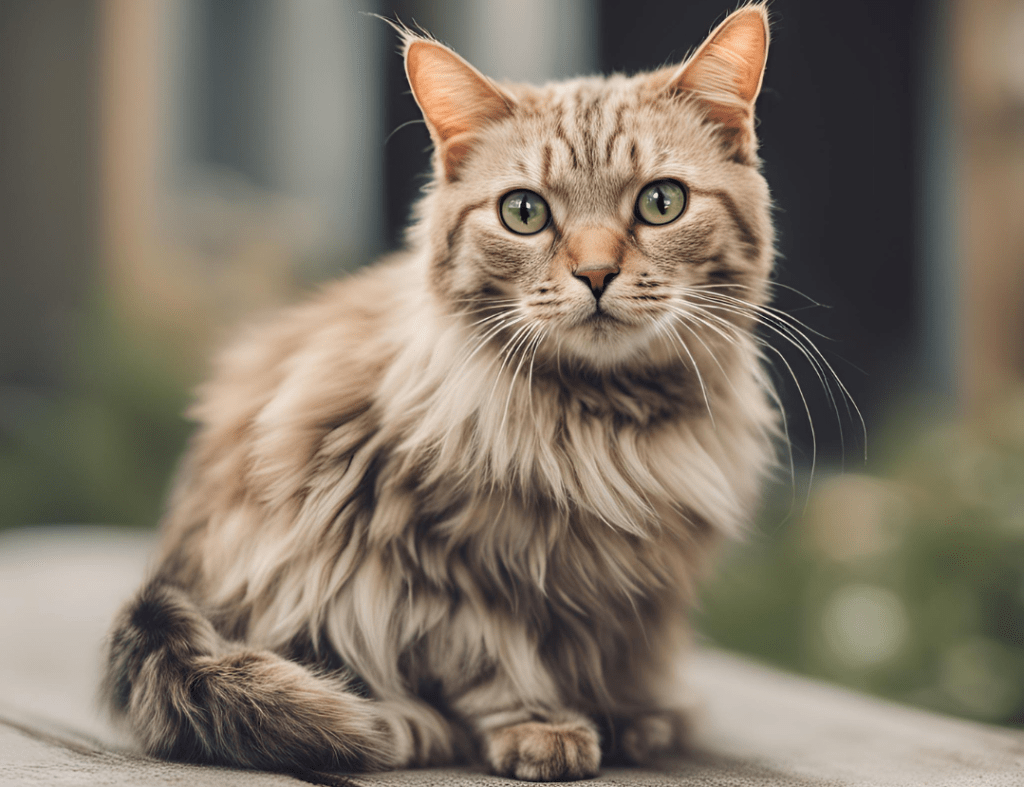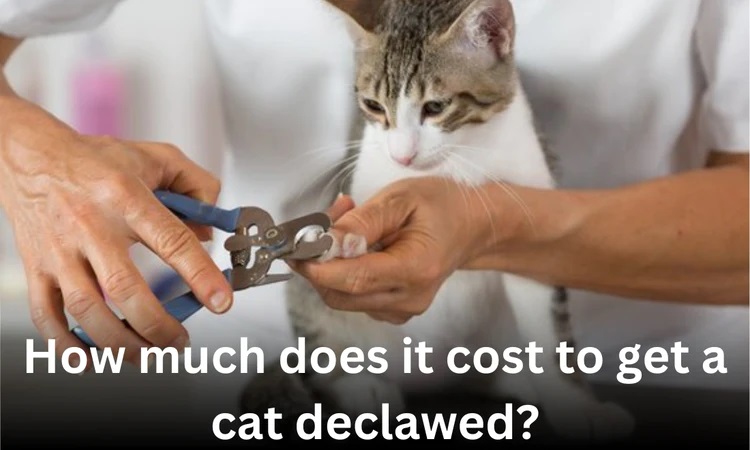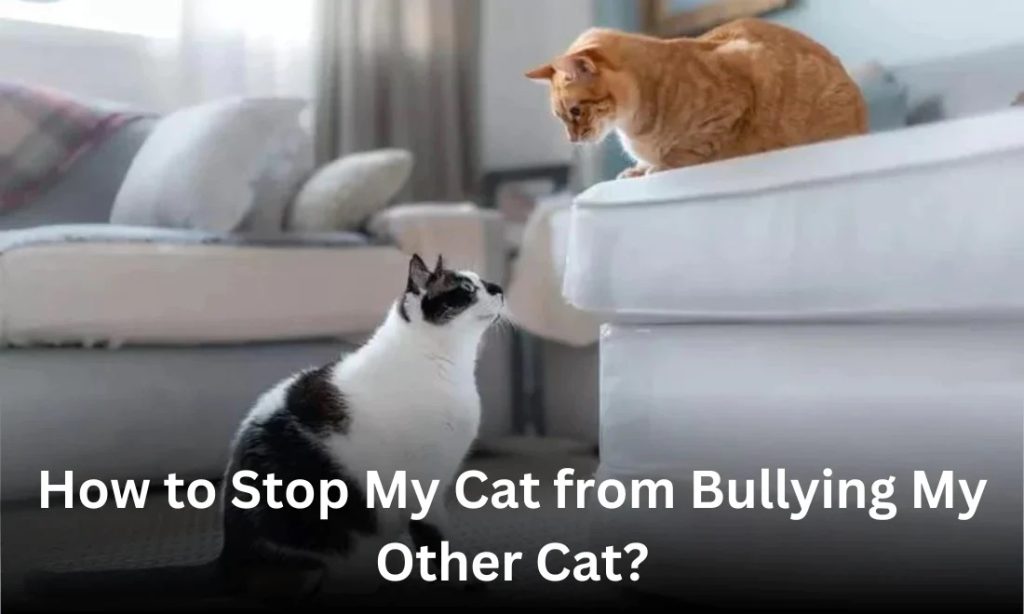Last updated on July 7, 2025
Blind cats deserve just as much fun and stimulation as their sighted counterparts. But, choosing the right toys for them requires extra care. This guide will help you find the best cat toys for blind cats, ensuring they stay happy and active.
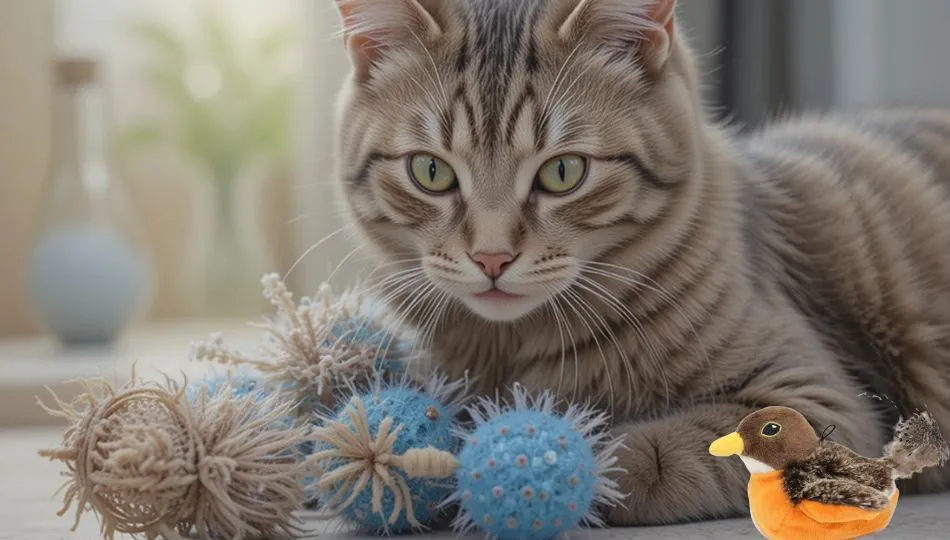
I want to talk about why it’s important to select the right toys for blind cats. This is a topic I deal with regularly. This blog post will mainly discuss the best toys for blind cats. It will also cover techniques to improve their general quality of life.
- Why Playtime Matters for Blind Cats
- What Consider to Look for in Cat Toys for Blind Cats
- Top 6 Types of Cat Toys for Blind Cats
- 1. Sound-Making Toys
- 2. Textured and Tactile Cat Toys for Blind Cats
- 3. Scent-Infused Toys
- 4. Interactive Cat Toys for Blind Cats
- 5. Puzzle Cat Toys for Blind Cats
- 6. Wand Toys with Sound Attachments
- Recommended Wand Toys for Blind Cats:
- What to Consider for Choosing?
- How to Use Wand Toys with Blind Cats:
- Safety Tips:
- DIY Cat Toys for Blind Cats
- Tips for Playing with Blind Cats
- Safety Considerations for Blind Cat Toys
- How to Encourage Play in Blind Cats
- Common Mistakes to Avoid
- Final Thoughts
Like people who are blind or visually impaired, cats are more dependent on their other senses. To navigate their environment, cats must rely on their senses of smell, hearing, touch, and even vibrations. I’m constantly in awe of blind cats’ remarkable adaptability and ability to thrive.
Playtime can occasionally become boring. This happens if the wrong toys are given. Nonetheless, blind cats can manage incredibly well indoors. They memorize object placement, estimate distances for jumps, and navigate stairs. This is the point at which careful selection becomes essential.
You need to consider a cat’s enhanced senses when choosing toys for a blind or visually impaired feline. Their enhanced senses are crucial in making a selection. Strong-smelling toys, like those containing valerian or catnip, are great choices. Jingling balls or rod toys with bells are examples of auditory toys that can be very entertaining. Toys with textures, like cardboard or fur, can also be interesting.
A straightforward do-it-yourself toy, such as a sealed toilet roll with holes and treats inside, can be an entertaining choice. It is engaging because the cat is guided by the scent of the treats while playing. We can make sure blind cats have a rewarding and enriching playtime experience by concentrating on these sensory aspects.
Why Playtime Matters for Blind Cats
Playtime is essential for all cats, including those without sight. It keeps them physically active and mentally stimulated. For blind cats, playtime also builds confidence and reduces anxiety.
Engaging toys can help blind cats navigate their environment better. They rely on their other senses, like hearing, touch, and smell. The right toys can enhance these senses and provide hours of entertainment.
What Consider to Look for in Cat Toys for Blind Cats
When shopping for toys, choose those that stimulate non-visual senses. Sound-based toys, textured items, and scented options work best. Avoid toys that rely solely on visual appeal.
Durability and safety are also crucial. Blind cats play more aggressively, so choose sturdy materials. Always check for small parts that pose a choking hazard.
Top 6 Types of Cat Toys for Blind Cats
1. Sound-Making Toys
Blind cats can still enjoy playtime with toys that engage their other senses, particularly sound. Here are some sound-making cat toys that are great for blind cats:
1. Crinkle Toys
- Made with materials that produce a crinkling sound when touched or batted.
- Often shaped like balls, fish, or small pillows.
- Great for cats who enjoy textures and sounds.
Why It’s Great: The crinkling sound is intriguing and easy for blind cats to locate.
2. Electronic Motion Toys
- Battery-operated toys that move and make sounds, such as chirping or squeaking.
- Examples include robotic mice or birds that mimic prey.
- Keeps cats entertained even when you’re not around.
3. Bell Toys
- Toys with small bells inside that jingle when moved.
- Common in ball toys or wand toys.
- Simple yet effective for stimulating play.
4. Chirping or Squeaking Toys
- Designed to mimic the sounds of birds or rodents.
- Often used in plush toys or interactive toys.
- Appeals to cats’ hunting instincts.
5. Rattle Toys
- Contain small beads or objects that rattle when shaken.
- Usually shaped like balls or small animals.
- Provides auditory and tactile stimulation.
6. Interactive Sound Toys
- Toys that respond to your cat’s actions with sounds.
- Examples include motion-activated toys or puzzle toys with sound rewards.
- Encourages problem-solving and engagement.
7. Catnip Toys with Sound Elements
- Description: Catnip-filled toys that also include bells, crinkles, or rattles.
- Why It’s Great: Combines the appeal of catnip with auditory stimulation.
8. Wand Toys with Sound Attachments
- Feather wands or string toys with attached sound-making elements (e.g., bells or crinkle attachments).
- Perfect for interactive play between you and your cat.
9. Tunnels with Hanging Sound Toys
- Description: Tunnels that have hanging toys with bells or crinkles inside.
- Why It’s Great: Provides a multi-sensory experience with both sound and touch.
9. Squeaky Plush Toys
- Description: Soft plush toys that squeak when squeezed.
- Why It’s Great: The squeaking sound can be very appealing and easy to locate.
10. DIY Sound Toys
- Description: Homemade toys using materials like aluminum foil, paper bags, or small containers with beads inside.
- Why It’s Great: Customizable and can be made from household items.
2. Textured and Tactile Cat Toys for Blind Cats
Cat toys with textures are created to engage your cat’s sense of touch. They offer a variety of surfaces and materials for exploration. These toys can stimulate your cat’s instincts to paw, scratch, bite, and knead, making them both fun and enriching. Here are some popular types of textured and tactile cat toys:
1. Crinkle Toys
- Made with crinkly materials (like mylar or plastic) that make noise when touched.
- Often combined with soft fabrics for added texture.
- Great for cats who enjoy both sound and touch.
2. Plush Toys with Different Textures
- Soft plush toys with added elements like ribbons, fleece, or faux fur.
- Some have crinkle inserts or rattles for extra stimulation.
- Ideal for cats who like to cuddle or carry toys in their mouths.
3. Rubber or Silicone Toys
- Durable toys with nubs, ridges, or grooves for chewing and pawing.
- Often used for teething kittens or cats who enjoy biting.
- Easy to clean and long-lasting.
4. Fabric or Knitted Toys
- Toys made from soft, textured fabrics like felt, fleece, or yarn.
- Often shaped like mice, fish, or balls.
- Lightweight and easy for cats to bat around.
5. Catnip-Infused Toys
- Toys filled with catnip and covered in textured materials like burlap, corduroy, or fleece.
- Encourages rolling, rubbing, and playful behavior.
- Available in various shapes, such as mice, balls, or pillows.
6. Scratching Pads or Boards with Textures
- Made from materials like corrugated cardboard, sisal, or carpet.
- Some have added textures like ridges or grooves for extra tactile stimulation.
- Doubles as a scratching surface to keep claws healthy.
7. Interactive Textured Toys
- Toys with multiple textures, such as a combination of soft fabric, crinkly material, and rubber.
- May include hidden compartments or pockets for treats.
- Encourages exploration and problem-solving.
8. Ball Toys with Textured Surfaces
- Balls made from materials like rubber, foam, or fabric with ridges, bumps, or holes.
- Some have bells or rattles inside for added interest.
- Perfect for batting and chasing.
9. Feather Toys with Textured Handles
- Wand toys with feathers or fabric strips attached to textured handles (e.g., rope or rubber).
- Allows for interactive play between you and your cat.
10. Puzzle Toys with Textured Elements
- Toys that require your cat to paw, scratch, or manipulate textured surfaces to access treats.
- Combines mental stimulation with tactile exploration.
11. Knitted or Crocheted Toys
- Why they work: The unique texture of knitted or crocheted materials is intriguing for blind cats. They explore these materials with their paws and mouths.
- Examples: Handmade crocheted balls or mice.
What to Consider for Choosing Textured and Tactile Cat Toys?
- Safety: Make sure that the toy is made from non-toxic materials and doesn’t have small parts that be swallowed.
- Durability: Choose toys that can withstand scratching, biting, and vigorous play.
- Variety: Offer a mix of textures to keep your cat engaged and prevent boredom.
- Cat Preferences: Observe what textures your cat enjoys most (e.g., soft, crinkly, or rough).
Textured and tactile toys can provide hours of entertainment for your cat. They provide enrichment and help satisfy your cat’s natural instincts. These toys keep them active. Rotate toys regularly to maintain their interest!
3. Scent-Infused Toys
Scent-infused cat toys are designed to captivate your cat’s keen sense of smell. This sense is a powerful driver of their behavior and play. These toys often incorporate enticing scents. Examples include catnip, silver vine, valerian root, or other natural attractants. These scents stimulate your cat’s curiosity. They encourage interaction. Here are some popular types of scent-infused cat toys and tips for using them effectively:
1. Catnip-Infused Toys
- What They Are: Toys filled with dried catnip, a herb that induces a euphoric reaction in many cats.
- Examples: Plush mice, balls, pillows, or stuffed animals.
- Why Cats Love Them: Catnip triggers playful behavior, rolling, rubbing, and pouncing in about 50-70% of cats.
2. Silver Vine Toys
- What They Are: Toys infused with silver vine. This plant has a similar effect to catnip. However, it is often more potent.
- Examples: Sticks, balls, or plush toys.
- Why Cats Love Them: Silver vine can attract even cats who don’t respond to catnip.
3. Valerian Root Toys
- What They Are: Toys containing valerian root, a natural herb that acts as a stimulant for cats.
- Examples: Scented plush toys or fabric pouches.
- Why Cats Love Them: Valerian root can induce playful or relaxed behavior, depending on the cat.
4. Tatarian Honeysuckle Toys
- What They Are: Toys made from or infused with Tatarian honeysuckle wood or scent.
- Examples: Chew sticks or small wooden toys.
- Why Cats Love Them: Many cats are attracted to the scent and enjoy chewing or rubbing on these toys.
5. Multi-Scented Toys
- What They Are: Toys that combine multiple scents, such as catnip, silver vine, and valerian root.
- Examples: Plush toys, balls, or interactive puzzles.
- Why Cats Love Them: The variety of scents can appeal to a wider range of cats. This can keep them engaged longer.
6. Scented Balls or Mice
- What They Are: Small, lightweight toys infused with catnip or other scents.
- Examples: Crinkly balls, fabric mice, or rubber toys.
- Why Cats Love Them: They’re perfect for batting, chasing, and carrying around.
7. Scented Scratching Pads or Posts
- What They Are: Scratching surfaces infused with catnip or other attractants.
- Examples: Cardboard scratchers, sisal posts, or carpeted pads.
- Why Cats Love Them: The scent encourages scratching, which helps keep claws healthy and satisfies instincts.
8. Refillable Scented Toys
- What They Are: Toys with pockets or compartments where you can add or replace scent fillers (e.g., dried catnip or silver vine).
- Examples: Plush toys with Velcro openings or fabric pouches.
- Why Cats Love Them: They provide long-lasting enjoyment as the scent can be refreshed.
Tips for Using Scent-Infused Cat Toys:
- Rotate Toys: Alternate scented toys to prevent your cat from becoming desensitized to the scent.
- Store Properly: Keep scent-infused toys in a sealed container to preserve their potency.
- Observe Reactions: Not all cats respond to the same scents. Experiment to see which ones your cat prefers.
- Use Sparingly: Overuse of catnip or other scents can reduce their effectiveness over time.
- Safety First: Ensure the toy is made from non-toxic materials and doesn’t have small parts that could be swallowed.
Scent-infused toys are a fantastic way to enrich your cat’s environment, encourage play, and satisfy their natural instincts. By incorporating these toys into your cat’s routine, you can keep them entertained and mentally stimulated!
4. Interactive Cat Toys for Blind Cats
1. Sound-Based Toys:
Toys that make noise, like crinkly balls, bells, or chirping toys, can help blind cats locate and engage with them.
Examples: Cat balls with bells inside, crinkle toys, or electronic toys that emit gentle sounds.
2. Motion-Activated Toys:
Toys that move or make noise when touched can keep a blind cat entertained.
Examples: Motion-activated rolling balls or toys that vibrate when batted.
3. Catnip or Silvervine Toys:
Scented toys can be very appealing to blind cats. Look for toys filled with catnip or silvervine to stimulate their sense of smell.
Examples: Catnip-filled mice, plush toys, or stuffed balls.
4. Feather Wands with Sound:
You can use feather wands with bells or crinkly attachments to play with your cat. Drag them across the floor or move them gently in the air.
5. Interactive Treat Dispensers:
Toys that dispense treats when manipulated can engage a blind cat’s sense of smell and encourage problem-solving.
Examples: Treat balls or puzzle feeders that make noise when rolled.
5. Puzzle Cat Toys for Blind Cats
1. Snuffle Mats:
These mats have hiding spots for treats or kibble, encouraging your cat to use their nose to search for food.
2. Scent-Based Puzzles:
Hide treats or catnip in a puzzle toy with compartments or layers. Your cat can use their sense of smell to locate the rewards.
Examples: Multi-level puzzle feeders or treat-dispensing cubes.
3. Textured Puzzle Toys:
Toys with different textures (soft, rough, bumpy) can be interesting for blind cats to explore with their paws and mouth.
Examples: Textured balls or toys with ridges and grooves.
4. DIY Puzzle Toys:
Create simple puzzles at home by hiding treats in cardboard boxes or egg cartons. You can also use muffin tins covered with balls or toys.
6. Wand Toys with Sound Attachments
Wand cat toys with sound attachments can be a great choice for blind cats. They rely more on their other senses, like hearing and touch, to interact with their environment.
Recommended Wand Toys for Blind Cats:
- Cat Dancer 021 Cat Charmer: This toy has colorful, crinkly fabric strips that make noise when moved.
- GoCat Da Bird Cat Toy: Attach a feather or sound-making attachment to this wand for an engaging experience.
- SmartyKat Skitter Critters Cat Toy: These small, noisy toys can be attached to a wand for interactive play.
- Petstages Tower of Tracks with Catnip Toys: While not a wand toy, this interactive toy makes sounds. It can be a great alternative for solo play.
Here are some ideas and tips for choosing and using wand toys with sound attachments for blind cats:
What to Consider for Choosing?
- Sound Attachments: Look for wand toys that have bells, crinkly materials, or squeakers. These sounds can help your cat locate the toy and engage with it.
- Textured Toys: Attachments with feathers, ribbons, or soft fabric can provide tactile stimulation.
- Lightweight and Easy to Move: A wand toy that is easy to maneuver will allow you to create unpredictable movements. These movements can keep your cat interested.
- Durable Materials: Make sure the toy is made from safe, non-toxic materials. Blind cats may rely more on chewing or biting during play.
How to Use Wand Toys with Blind Cats:
- Start Slowly: Gently move the toy and make sounds to help your cat locate it. Avoid sudden, loud noises that might startle them.
- Use Consistent Sounds: Use the same sound cues each time you play. This helps your cat associate the sound with playtime.
- Encourage Exploration: Let your cat sniff and touch the toy to familiarize themselves with it before starting to play.
- Vary the Movement: Move the toy in different directions and at different speeds to keep your cat engaged.
- Interactive Play: Spend time playing with your cat to build trust and strengthen your bond. Blind cats may rely more on your presence for reassurance.
Safety Tips:
- Always supervise playtime to ensure your cat doesn’t accidentally swallow small parts.
- Avoid toys with sharp edges or loose components that could harm your cat.
- Rotate toys regularly to keep your cat interested and prevent boredom.
By incorporating sound and texture into playtime, you can help your blind cat enjoy a stimulating and enriching experience!
DIY Cat Toys for Blind Cats
You don’t need to spend a fortune to keep your blind cat entertained. Simple DIY toys can be just as effective. For example, tie a bell to a string or fill a sock with catnip.
Another idea is to use empty cardboard boxes or paper bags. These create safe spaces for exploration and play. Always supervise your cat to ensure their safety.
Tips for Playing with Blind Cats
Introduce new toys gradually to avoid overwhelming your cat. Use sound or scent to guide them toward the toy. Be patient and let them explore at their own pace.
Engage in interactive play to strengthen your bond. Move toys slowly and consistently to help your cat track them. Always end playtime on a positive note with a treat or cuddle.
Safety Considerations for Blind Cat Toys
Always inspect toys for loose parts or sharp edges. Replace damaged toys immediately to prevent accidents. Choose toys made from non-toxic materials to ensure your cat’s safety.
Avoid toys with long strings or small detachable parts. These can be dangerous if swallowed. Stick to larger, sturdy toys that are easy for your cat to handle.
How to Encourage Play in Blind Cats
Create a safe and stimulating environment for your blind cat. Use toys that appeal to their senses and rotate them regularly. This keeps playtime fresh and exciting.
Incorporate play into their daily routine. Consistent play sessions help blind cats feel secure and confident. Always reward their efforts with praise or treats.
Common Mistakes to Avoid
Avoid overwhelming your cat with too many toys at once. Stick to one or two toys per play session. This helps them focus and enjoy the experience.
Don’t force your cat to play if they’re not interested. Respect their boundaries and try again later. Playtime should always be a positive experience.
Final Thoughts
Blind cats can lead happy, fulfilling lives with the right care and attention. Choosing the right toys is a simple way to enrich their daily routine. By focusing on sound, texture, and scent, you can provide endless fun for your feline friend.
Remember, every cat is unique. Experiment with different toys to find what your blind cat loves most. With patience and creativity, you can make playtime a joyful experience for both of you.


